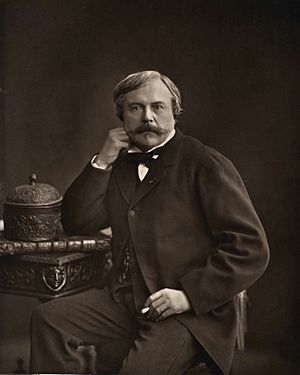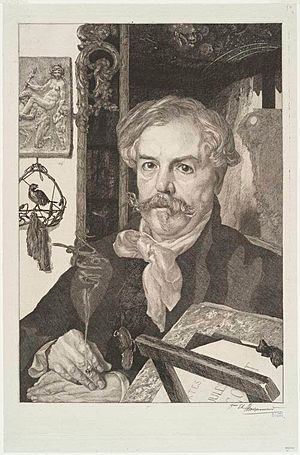Edmond de Goncourt facts for kids
Quick facts for kids
Edmond de Goncourt
|
|
|---|---|
 |
|
| Born | 26 May 1822 Nancy, France |
| Died | 16 July 1896 (aged 74) Draveil, France |
| Resting place | Cimetière de Montmartre |
| Occupation | Writer, literary critic, art critic, book publisher |
| Signature | |
Edmond de Goncourt (born May 26, 1822 – died July 16, 1896) was a French writer. He was also an art critic and a book publisher. He is famous for starting the Académie Goncourt, which gives out a very important French literature prize.
Edmond's Life Story
Edmond de Goncourt was born in Nancy, France. His parents were Marc-Pierre and Annette-Cécile de Goncourt. They were from a noble family. Sadly, his parents passed away when Edmond and his brother, Jules de Goncourt, were young adults.
His father was a cavalry officer. He served in Napoleon I's army. His grandfather was part of the French National Assembly in 1789. Edmond went to several schools, including Lycée Henri IV. He studied rhetoric and philosophy. Later, he studied law from 1842 to 1844.
After their mother died in 1848, the brothers received money. This allowed them to live on their own. They could then follow their interests in art and writing.
For most of his life, Edmond worked with his brother Jules. They wrote many books together. They also created art criticism pieces. They kept a famous diary called the Goncourt Journal. They also wrote several novels. One of their early books was about working-class people. It is seen as one of the first "Realism" books in France. This style showed life as it truly was.

Edmond was very interested in Rococo art. This is a fancy and playful art style from the 1700s. He also loved Japanese art. He collected many rare books too. In 1868, the brothers bought a house in Auteuil. This house was like a museum for their art collection. It had French art from the 1700s and art from the Far East. Edmond wrote a book about his house in 1881. It was called "La Maison d'un Artiste" (An Artist's House).
Between 1856 and 1875, the brothers wrote essays about 18th-century art. These were put together in a series called "L'Art du XVIIIe siècle" (The Art of the 18th Century). Their work helped people appreciate Rococo art again.
After Jules's Death
Jules de Goncourt died in 1870. After this, Edmond continued to write novels by himself. He also kept writing the Journal des Goncourt. He and Jules had started this diary in 1851. Edmond only stopped writing in it 12 days before he died in 1896.
He finished some works that he and Jules had started. These included a book about Paul Gavarni (1873). He also finished a book called "L'Amour au XVIIIe Siècle" (Love in the 18th Century) in 1875. His last novel was Chérie (1884). It was about a young woman who showed her artistic style through fashion. This book explored a type of art called Impressionism.
In 1885, he collected letters from his late brother. Between 1887 and 1896, he published nine volumes of the Journal.
Edmond de Goncourt left all his money to start the Académie Goncourt. This was to honor his brother and their work together. Every December since 1903, the Académie gives out the Prix Goncourt. This is the most important prize in French language literature. It is given to the best story written in French each year.
Edmond de Goncourt passed away in Champrosay in 1896. He was buried in the Cimetière de Montmartre in Paris.

Edmond's Books
(written by Edmond alone)
Nonfiction
- Catalogue raisonné de l'oeuvre peint, dessiné et gravé d'Antoine Watteau (1875)
- Catalogue raisonné de l'œuvre peint, dessiné et gravé de P. P. Prud'hon (1876)
- La Maison d'un Artiste (An Artist's House) (1881)
- La Saint-Huberty (1884)
- L'Art japonais du XVIIIe siècle, Outamaro. Le peintre des maisons vertes (Japanese Art of the 18th Century, Utamaro. The Painter of Green Houses) (1891)
- La Guimard, d'après les registres des Menus Plaisirs, de la bibliothèque de l'Opéra, etc. (1893)
- L'Art japonais du XVIIIe siècle, Hokousai (Japanese Art of the 18th Century, Hokusai) (1896)
- Le Grenier (The Attic) (1896)
Novels
- La Fille Elisa (1877)
- Les Frères Zenganno (The Zenganno Brothers) (1878)
- La Faustin (1882)
- Chérie (1884)
- Goncourt Journal
See also
 In Spanish: Edmond de Goncourt para niños
In Spanish: Edmond de Goncourt para niños

